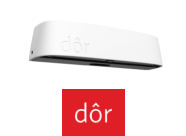How does thermal people counter technology work?
Put simply, thermal sensors are devices that detect heat. When it comes to door counters, thermal sensors detect the light generated by body heat radiating off people as they walk past the sensor. One of the best advantages of using thermal sensors is that they provide anonymous data regarding the people they track in addition to having low-cost & quick installation ability.
Where can the thermal people counters be used?
Thermal sensors can suit just about any business that is looking to analyze foot traffic and grow from the data. Their anonymity also makes them a great solution for businesses that may have privacy concerns or must comply with privacy requirements. Businesses that are an ideal match for a thermal sensor include retailers, co-working spaces, offices and other large facilities.
What is the average cost of thermal people counting systems?
Although prices vary, thermal sensors are typically cheaper than video camera sensors. Dor is a new-generation battery-powered thermal sensor that helps lower installation and maintenance costs for businesses. Not only does the battery only need to be changed every two years, but Dor's thermal sensor can also be installed in minutes. All you have to do is just peel and stick the sensor anywhere you want, and it will start counting people right away. By eliminating the need for technicians as well as installation costs, this type of technology can save businesses a lot of time and effort – especially those with hundreds of stores or ones who can't afford to close temporarily to install a sensor.
What are the benefits of thermal people counting sensors?
Other than the easy and low-cost installation, another great benefit to using a thermal door counter is undoubtedly the anonymity aspect: Not only are the thermal images blurred as compared to a video camera, but thermal sensors also don't rely on obtaining mobile data from visitors, as is the case with WiFi, break-beam and Bluetooth beacons. Thermal sensors are also significantly more accurate than WiFi, break-beam and Bluetooth beacon technologies. Here again, Dor's thermal sensor stands out from the competition, as it was developed using a machine learning algorithm that allows the sensor to constantly learn and get more accurate at counting people each day.
What are the limitations of thermal people counting sensors?
While the privacy factor is critical for many businesses, the anonymous data you get from using a thermal sensor doesn’t let you learn anything about your foot traffic’s demographical data or behaviors. So, this may be a limitation for retailers looking to learn more about their customers, such as their age groups and genders.




 Thermal Sensor
Thermal Sensor





